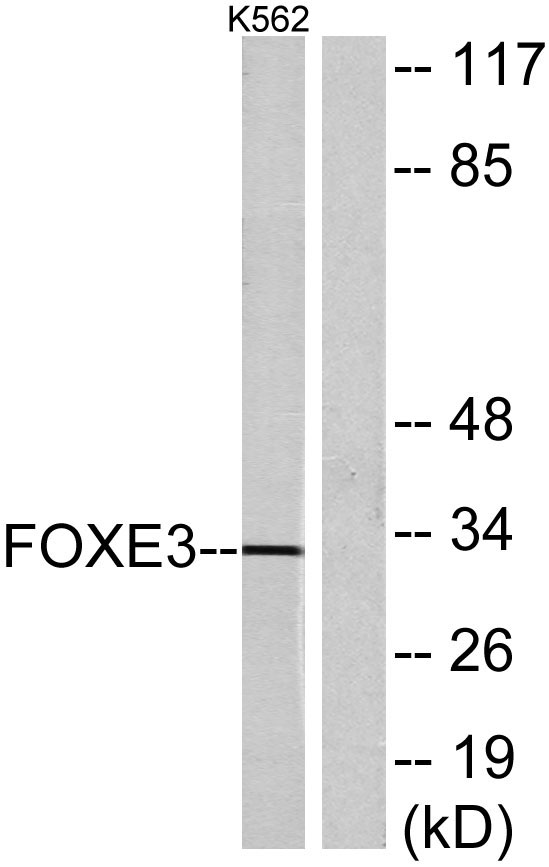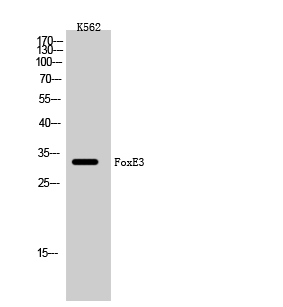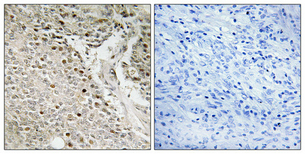产品名称
FoxE3 Rabbit Polyclonal Antibody
别名
FOXE3; FKHL12; FREAC8; Forkhead box protein E3; Forkhead-related protein FKHL12; Forkhead-related transcription factor 8; FREAC-8
蛋白名称
Forkhead box protein E3
存储缓冲液
Liquid in PBS containing 50% glycerol, 0.5% BSA and 0.02% New type preservative N.
Human Gene Link
http://www.ncbi.nlm.nih.gov/sites/entrez?db=gene&term=2301
Human Swissprot No.
Q13461
Human Swissprot Link
http://www.uniprot.org/uniprotkb/Q13461/entry
Mouse Gene Link
http://www.ncbi.nlm.nih.gov/sites/entrez?db=gene&term=30923
Mouse Swissprot No.
Q9QY14
Mouse Swissprot Link
http://www.uniprot.org/uniprot/Q9QY14
Rat Swissprot Link
http://www.uniprot.org/uniprot/Q63250
免疫原
The antiserum was produced against synthesized peptide derived from human FOXE3. AA range:81-130
特异性
FoxE3 Polyclonal Antibody detects endogenous levels of FoxE3 protein.
稀释度
WB 1:500 - 1:2000. IHC 1:100 - 1:300. ELISA: 1:20000.. IF 1:50-200
宿主
Polyclonal, Rabbit,IgG
背景介绍
This intronless gene belongs to the forkhead family of transcription factors, which is characterized by a distinct forkhead domain. The protein encoded functions as a lens-specific transcription factor and plays an important role in vertebrate lens formation. Mutations in this gene are associated with anterior segment mesenchymal dysgenesis and congenital primary aphakia. [provided by RefSeq, Dec 2009],
功能
disease:Defects in FOXE3 are a cause of anterior segment mesenchymal dysgenesis (ASMD) [MIM:107250]; also known as anterior segment ocular dysgenesis (ASOD). ASMD includes all malformations involving the first (corneal endothelium and trabecular meshwork), second (corneal stroma) and third (iris stroma) mesenchymal waves of neural crest. The ASMD phenotype is characterized by corneal opacities with or without iris adhesions in 100%, cataracts of varying severity in 100% and optic-nerve abnormalities in 20% of affected individuals.,disease:Defects in FOXE3 are a cause of congenital primary aphakia (CPA) [MIM:610256]. Human aphakia is a rare congenital eye disorder in which the lens is missing. It has been histologically subdivided into primary and secondary forms, in accordance with the severity of defects of the ocular tissues, whose development requires the initial presence of a lens. CPA results from an early developmental arrest, around the 4th-5th week of gestation in humans, that prevents the formation of any lens structure and leads to severe secondary ocular defects, including a complete aplasia of the anterior segment of the eye. In contrast, in secondary aphakic eyes, lens induction has occurred, and the lens vesicle has developed to some degree but finally has progressively resorbed perinatally, leading, therefore, to less-severe ocular defects.,similarity:Contains 1 fork-head DNA-binding domain.,
纯化
The antibody was affinity-purified from rabbit antiserum by affinity-chromatography using epitope-specific immunogen.



